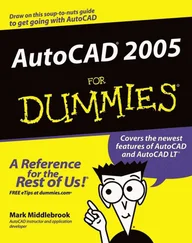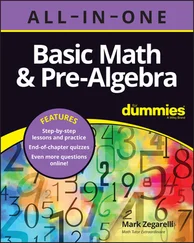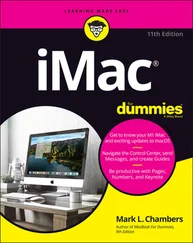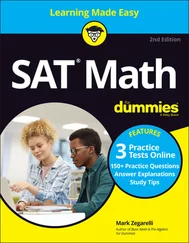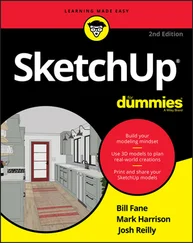Plate. The plate is a thick, round piece of steel containing several holes. It fits onto the end of the body and holds the worm in position as it spins. The size of the holes on the plate determines how coarse or fine your ground meat will be.
Locking ring. The locking ring holds the plate in place, securing all of the moving parts of your grinder.
For the purposes of this book, I will discuss three types of meat grinders. The size of the grinder you choose will be largely determined by the amount of meat that you plan to grind. This will also determine the size of the grinder you choose.
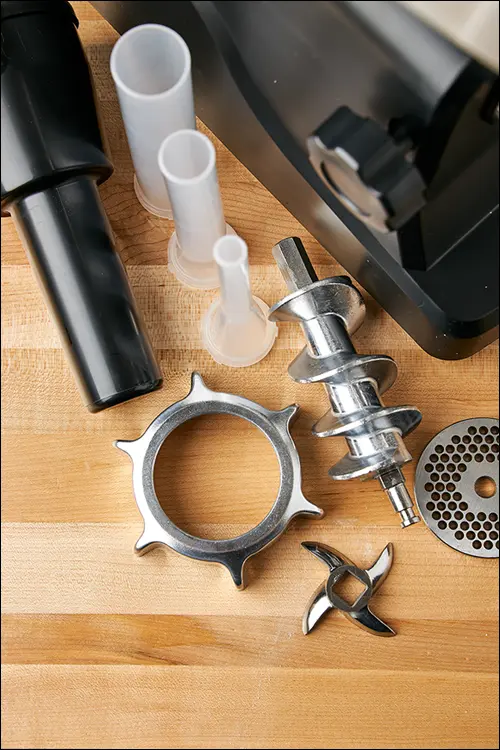
Photo by David Pluimer
FIGURE 1-1:Meat grinder parts.
Manual meat grinders are exactly what you might imagine: grinders that are human powered. The working parts are the same as previously described, but instead of an electric motor to turn the worm and knife, you have a hand crank, as shown in Figure 1-2.
Manual meat grinders cost less than electric meat grinders because they don’t contain any motorized parts. This is probably how your grandma or grandpa used to make sausage. Manual meat grinders must be clamped onto a hard surface like a table- or countertop. Manual meat grinders are lower in cost and maintenance than their electric workhorse big brothers, which is why they are a great starting point. Manual grinders can also be used anywhere because they do not require electricity.
KitchenAid mixer attachment grinder
Several years ago I bought my wife a KitchenAid mixer for Christmas. In all honesty, I bought it for myself but told my wife it was for her. This was a wonderful upgrade to our kitchen because of all the delightful baked goods we could make without all the excessive manual labor. I’m kind of like Tim “The Tool Man” Taylor: I like more power when it comes to my cooking tools!
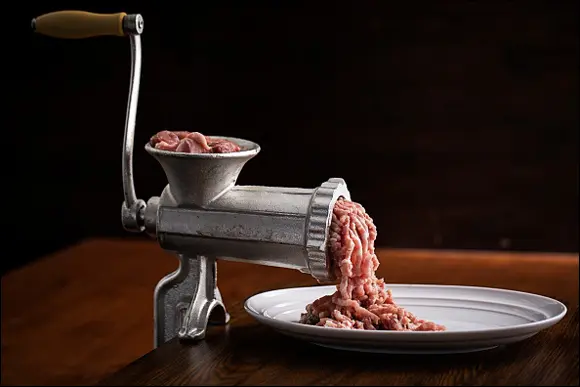
© Getty Images/The Washington Post
FIGURE 1-2:Manual meat grinder.
If you happen to have a KitchenAid mixer, then you’ll notice that the front of the mixer has a place for attaching add-on equipment. One of the attachments you can purchase from KitchenAid for your mixer is a meat grinder, pictured in Figure 1-3.

Photo by David Pluimer
FIGURE 1-3:KitchenAid attachment port and grinder attachment.
 The KitchenAid grinder attachment is great for testing the waters of making sausage. The parts are all the same as on a manual grinder, but you get a nice upgrade from the laborious task of manually grinding by using the grinder attachment with your KitchenAid mixer. This is, however, not a good long-term solution. Your mixer was specifically designed as a mixer, not a meat grinder, and so excessive use as a grinder with the attachment can greatly shorten the lifespan of your KitchenAid mixer.
The KitchenAid grinder attachment is great for testing the waters of making sausage. The parts are all the same as on a manual grinder, but you get a nice upgrade from the laborious task of manually grinding by using the grinder attachment with your KitchenAid mixer. This is, however, not a good long-term solution. Your mixer was specifically designed as a mixer, not a meat grinder, and so excessive use as a grinder with the attachment can greatly shorten the lifespan of your KitchenAid mixer.
As you navigate your own internal decision tree, give yourself a little time when it comes to selecting your meat grinder. Unless you have compelling reasons for not getting an electric grinder, like budget or access to power, this is where you should really focus your research. Electric meat grinders are the right tool for the job when it comes to grinding meat! They come in all shapes and sizes, which are largely determined by the intended volume of use. As with the KitchenAid attachment and the manual meat grinder, the parts of an electric meat grinder are the same with the exception of the electric motor, as shown in Figure 1-4.

Photo by David Pluimer
FIGURE 1-4:Electric meat grinder.
 Budget and intended use are major determining factors when selecting a meat grinder. If you plan to use your meat grinder more than once a year or to grind more than ten pounds of meat at a time, then you should consider an electric grinder. This will save you time, energy, and blisters.
Budget and intended use are major determining factors when selecting a meat grinder. If you plan to use your meat grinder more than once a year or to grind more than ten pounds of meat at a time, then you should consider an electric grinder. This will save you time, energy, and blisters.
Sizing and choosing your grinder
Grinder size is determined by the size of the plate that the grinder uses.
 The plate is a circular piece of steel covered in holes that fits on the end of the worm and determines how coarse or fine your ground meat will be.
The plate is a circular piece of steel covered in holes that fits on the end of the worm and determines how coarse or fine your ground meat will be.
The grinder size is denoted by a number, and this number corresponds to the diameter of the plate. The correlation of grinder size to plate size is shown in the following table:
| Grinder Size |
5 |
8 |
12 |
22 |
32 |
| Diameter of Plate |
2 1/8” |
2 1/2” |
2 3/4” |
3 1/4” |
3 7/8” |
Generally speaking, the larger the size of the grinder, the larger the motor, and thus the higher the cost of the grinder. If you are planning to use your grinder a few times a year to grind less than a few hundred pounds of meat, then you can definitely get by with a number 5 or 8 grinder. For a comparison, Figure 1-5 illustrates some of the different sizes of grinder plates up to number 32.
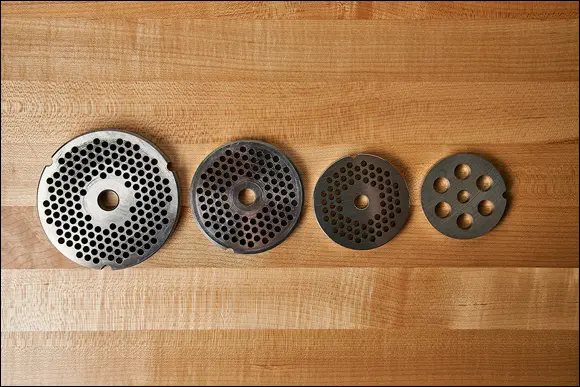
Photo by David Pluimer
FIGURE 1-5:Sausage grinder plates of different sizes.
One other determining factor when choosing a grinder is the materials from which your grinder is made. Stainless steel is the industry standard because it is durable, easy to clean, and resistant to rust. However, you can save money by going with plastic or aluminum options.
A sausage stuffer’s job is simple: to get ground meat into some sort of casing. There are a few types of sausage stuffer, but the most useful stuffer is called a vertical sausage stuffer (see Figure 1-6). Strictly speaking, stuffers are quite simple and are composed of the following parts:
Cylinder. The cylinder holds your meat mixture.
Piston. The piston fits perfectly into the cylinder and forces your meat mixture down through the cylinder. The piston is forced down by a hand crank.
Horn. The horn attaches to the bottom of the cylinder and is the approximate diameter of the sausage you are stuffing. Your casing fits onto the horn.
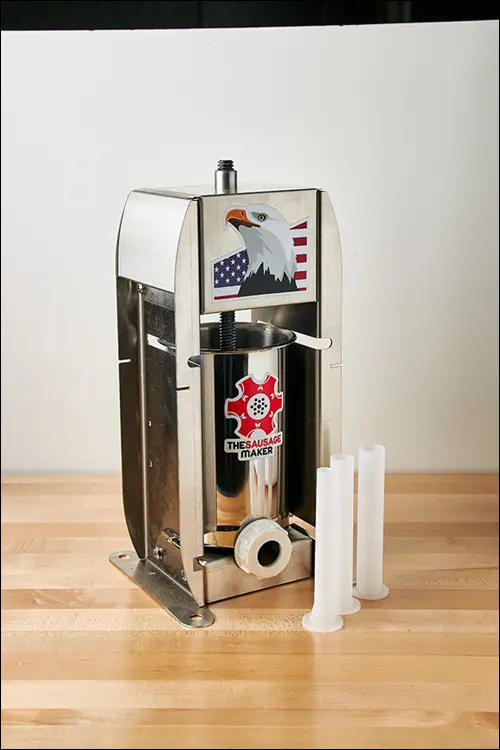
Photo by David Pluimer
FIGURE 1-6:Vertical stuffer and parts.
Vertical stuffers are ideal because their orientation gives you the greatest mechanical advantage as you crank the piston down. They are also ideal for stuffing a wet mixture like the emulsified sausages discussed in Chapter 6.
Читать дальше
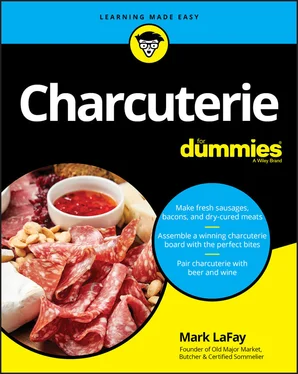



 The KitchenAid grinder attachment is great for testing the waters of making sausage. The parts are all the same as on a manual grinder, but you get a nice upgrade from the laborious task of manually grinding by using the grinder attachment with your KitchenAid mixer. This is, however, not a good long-term solution. Your mixer was specifically designed as a mixer, not a meat grinder, and so excessive use as a grinder with the attachment can greatly shorten the lifespan of your KitchenAid mixer.
The KitchenAid grinder attachment is great for testing the waters of making sausage. The parts are all the same as on a manual grinder, but you get a nice upgrade from the laborious task of manually grinding by using the grinder attachment with your KitchenAid mixer. This is, however, not a good long-term solution. Your mixer was specifically designed as a mixer, not a meat grinder, and so excessive use as a grinder with the attachment can greatly shorten the lifespan of your KitchenAid mixer.
 Budget and intended use are major determining factors when selecting a meat grinder. If you plan to use your meat grinder more than once a year or to grind more than ten pounds of meat at a time, then you should consider an electric grinder. This will save you time, energy, and blisters.
Budget and intended use are major determining factors when selecting a meat grinder. If you plan to use your meat grinder more than once a year or to grind more than ten pounds of meat at a time, then you should consider an electric grinder. This will save you time, energy, and blisters.

